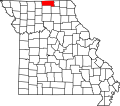Putnam County, Missouri | |
|---|---|
 Putnam County Courthouse in Unionville | |
 Location within the U.S. state of Missouri | |
 Missouri's location within the U.S. | |
| Coordinates: 40°29′N93°01′W / 40.48°N 93.02°W | |
| Country | |
| State | |
| Founded | February 28, 1845 |
| Named after | Israel Putnam |
| Seat | Unionville |
| Largest city | Unionville |
| Area | |
• Total | 520 sq mi (1,300 km2) |
| • Land | 517 sq mi (1,340 km2) |
| • Water | 2.3 sq mi (6.0 km2) 0.4% |
| Population (2020) | |
• Total | 4,681 |
| • Density | 9.05/sq mi (3.50/km2) |
| Time zone | UTC−6 (Central) |
| • Summer (DST) | UTC−5 (CDT) |
| Congressional district | 6th |
| Website | nemr |
Putnam County is a county in north central Missouri. At the 2020 census, the population was 4,681. [1] Its county seat is Unionville. [2] The county was organized February 28, 1845, and named for Israel Putnam, a hero in the French and Indian War and a general in the American Revolutionary War. [3]
Contents
- Geography
- Adjacent counties
- Major highways
- Demographics
- 2020 census
- 2010 census
- Education
- Public schools
- Public libraries
- Communities
- City
- Villages
- Unincorporated communities
- Politics
- Local
- State
- Federal
- See also
- References
- External links
Putnam County was established February 28, 1845, from parts of Adair and Sullivan counties. The following year a portion of Putnam was removed to form Dodge County. Both Putnam and Dodge extended nearly nine miles further north until an 1851 ruling by the Supreme Court on a border dispute with Iowa assigned the contested land to Iowa. Both counties were left with less than the statutory minimum area for a county as set by the state legislature, so Dodge County was dissolved and its area added to Putnam. [4]
In its early years, the county seat changed frequently, often with contentious debate. Putnamville, Bryant Station (both no longer in existence), and Hartford all served until a central location called Harmony, later renamed Unionville, was chosen. [5]
In the 1860 U.S. Census Putnam County had 9,240 residents, with eighteen sawmills and three flour mills. [6] Coal had been an abundant since its earliest settlement. Following the arrival of the Burlington & Southwestern Railway in 1873, coal mining became a major industry, especially in the east of the county. At one time three railroads crossed Putnam county: the Chicago, Milwaukee and St. Paul; the Chicago, Burlington and Quincy; and the Iowa and St. Louis. [7] Putnam County lost over two-thirds of its population between 1900 and 2000 (see census data below), when the United States changed from a rural to an urban country.
